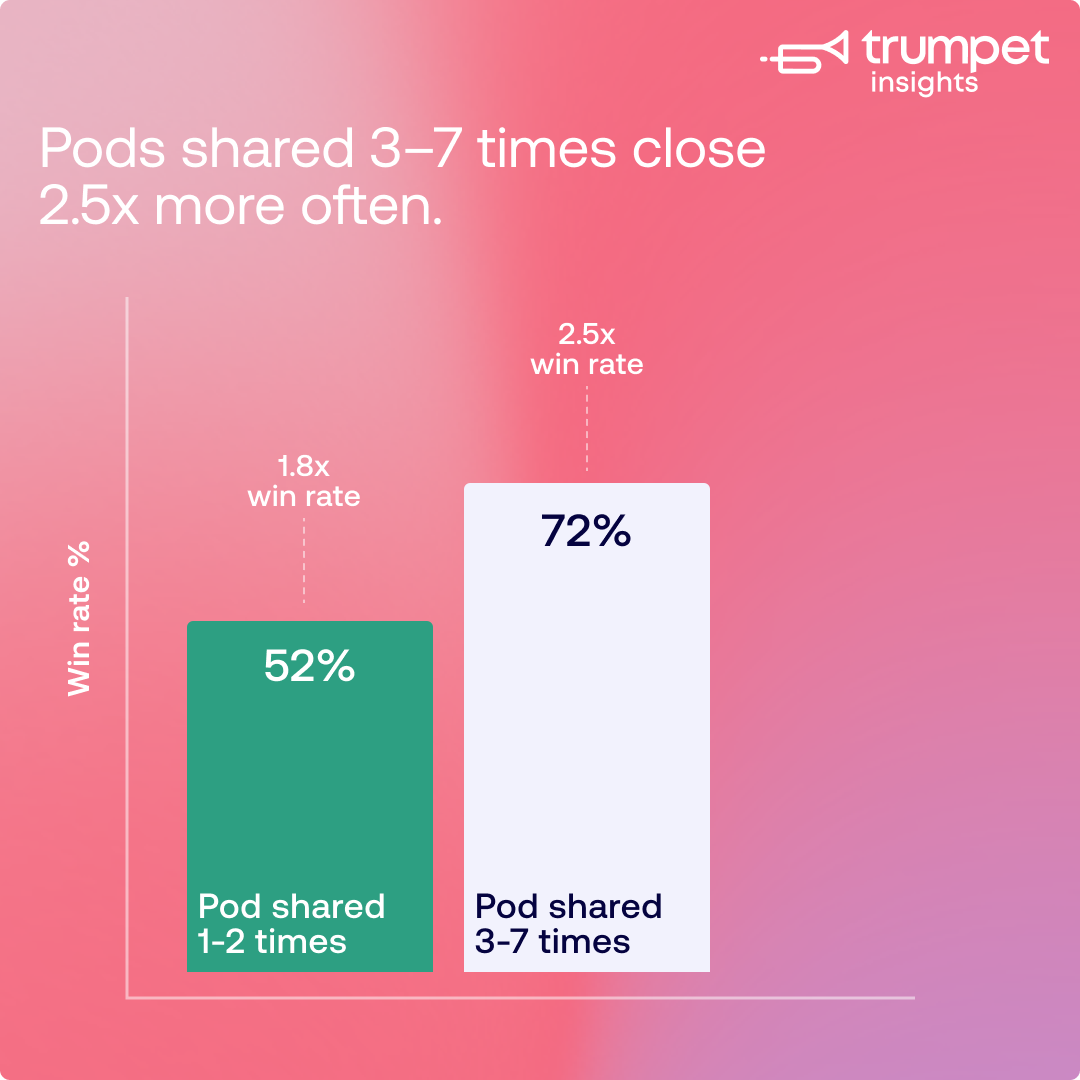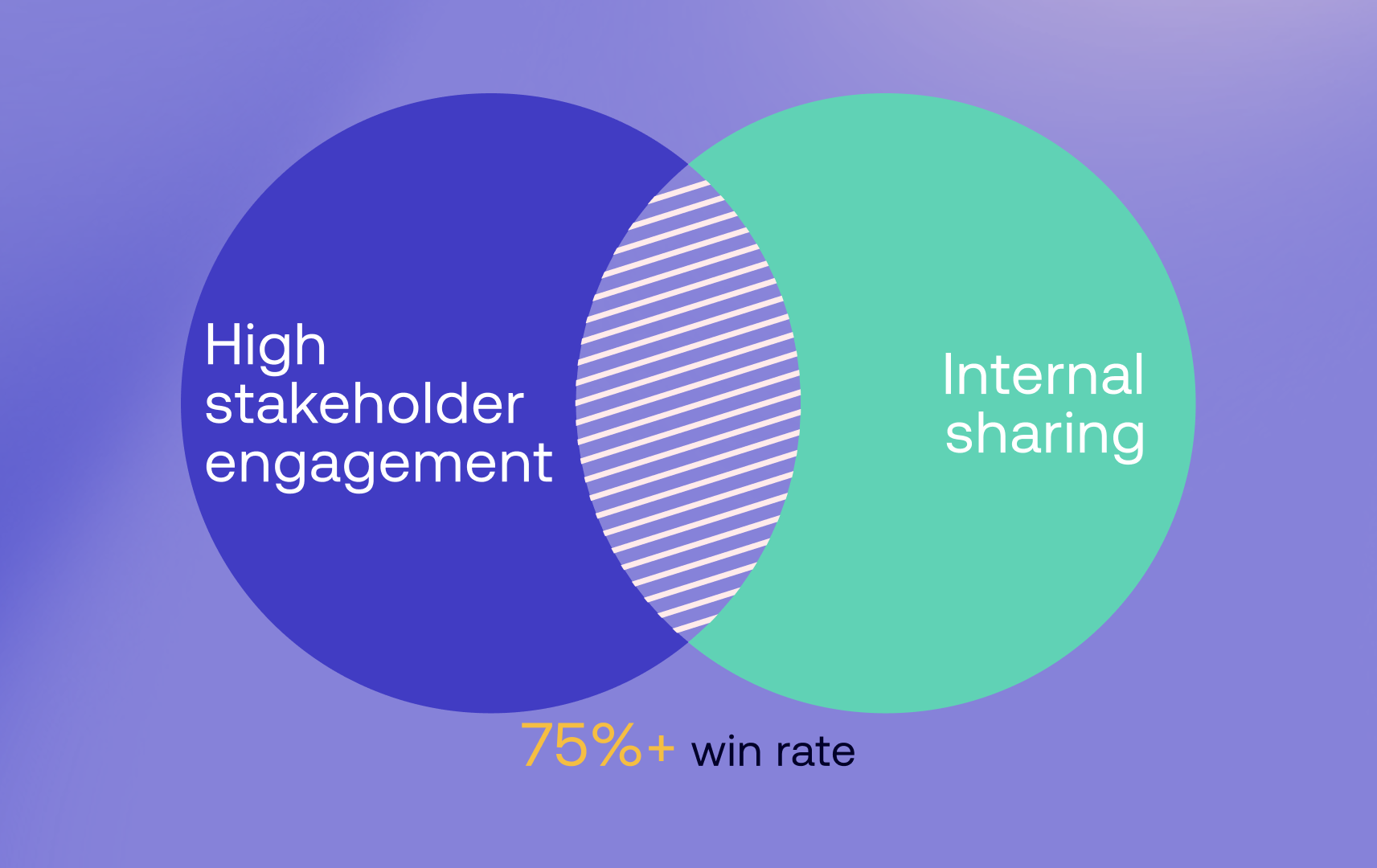Key takeaways:
- Pods shared internally just 1–2 times see a 52% win rate, a 1.8x lift over deals that aren’t shared.
- When a Pod is shared 3–7 times, win rates climb to 72%, a 2.5x increase.
- Internal sharing signals real buying momentum, champions are building consensus, surfacing blockers, and securing approvals.
- Deals with both high stakeholder engagement and internal sharing reach 75%+ close rates.
- Encourage sharing by making your Pod relevant, clear, and easy to forward, not by asking directly.
You’ve probably heard this one before:
“If your champion has to sell internally without you, you’ve already lost.”
But what if you could actually see that internal selling happening - in real time?
At trumpet, we analysed thousands of Digital Sales Rooms (Pods) and found something that flips the traditional idea of deal health on its head:
Internal sharing isn't just a good sign - it’s one of the most powerful predictors that your deal will close.
Let’s take a closer look.
Why internal sharing matters
Every time your champion shares a Pod internally, they’re doing the heavy lifting on your behalf.
They’re pitching the deal to stakeholders.
They’re validating the decision with their boss.
They’re bringing blockers into the open - before they become deal-killers.
In short, internal sharing is a high-signal behaviour. And now, we have the data to back that up.
Internal shares increase your win rate… Significantly
The numbers speak for themselves.
Pods that were shared internally - even just once or twice - had a 52% win rate compared to those that weren’t shared at all.
That’s a 1.8x increase, and interestingly, those deals actually closed faster on average.

But the real jump came when Pods were shared more widely.
When a Pod was shared internally between three and seven times, the win rate increased by 72%.
That’s right - 2.5x.
Deals with this level of internal traction may take slightly longer to close, but the lift in conversion is undeniable. These are engaged buying teams, doing the legwork for you.
Why more shares = more momentum
So why does internal sharing correlate so strongly with success?
Because it’s the clearest sign of momentum you can’t manufacture. You didn’t CC five stakeholders. Your champion did that - organically.
Here’s what internal shares typically mean:
- Consensus building: Your buyer is seeking approval
- Internal advocacy: Your champion is confident enough to forward your proposal
- Increased visibility: Decision-makers are being looped in
- Friction surfacing: Potential blockers are stepping into the room
That last one might make you nervous. It shouldn’t. You want those friction points early, not at signature stage.
Real multi-threading happens inside the buyer's business
It’s easy to confuse CRM multi-threading with real-world engagement. Adding stakeholders to an opportunity record isn’t the same as actual involvement.
But when a Pod gets forwarded internally? That’s the real signal.

The combination of high stakeholder engagement and internal sharing is where deals truly take off. In fact, when both are present, we’ve seen close rates climb to over 75%.
How to encourage internal sharing (without being annoying)
You can’t force your buyer to forward a Pod. But you can create the conditions that make it easy - and valuable - for them to do so.
Here’s how top-performing reps drive internal sharing:
→ Build it for them, not for you
Make the Pod worth sharing: include relevant testimonials, FAQs, pricing, and key decision-making info.
→ Pre-empt cross-functional concerns
Add content tailored for legal, IT, procurement and finance up front. That way, your champion doesn’t have to dig it out later.
→ Ask the right question
Not: “Can you share this internally?”
Try: “Would it be helpful if I added something for your [legal/finance/etc] team?”
→ Track and respond
With trumpet, you’ll know when a Pod gets shared - and who views it. Use that insight to follow up with the right content and timing.
What to avoid
Internal sharing doesn’t work if the content shared is generic, bloated, or confusing.
Some red flags:
- Too much too soon: Overloading your Pod makes it harder to navigate - and less likely to be shared
- Unstructured messaging: A messy Pod forces your champion to explain it - and they won’t
- Lack of role relevance: If there’s nothing tailored for finance, IT, or legal - they’ll ask for it elsewhere
Think of your Pod like a toolkit. If it’s easy to use and covers the essentials, it’ll travel far.
Final thoughts: internal shares = internal momentum
When champions pass your Pod around, they’re not just spreading information.
They’re building buy-in, surfacing blockers, and accelerating alignment. Your job isn’t to force that behaviour. It’s to make it frictionless - by designing Pods that are clear, relevant and built for the whole buying team.

.svg)
.svg)
.svg)
.svg)
.svg)
.svg)
.svg)
.svg)
.svg)
.png)
.svg)
.svg)
.svg)
.svg)

.svg)
.svg)
%201.svg)
.svg)
%201.svg)



.svg)





.png)













![How to Get Started with Buyer Enablement [With Examples]](https://cdn.prod.website-files.com/65cf4fecbed2754c2236665d/65cf4fecbed2754c22366bdb_65a5af83e742f76e34ce06f3_Customer%2520Onboarding%2520_%2520Everything%2520you%2520need%2520(2).png)
.png)



.png)



.png)












.png)


.png)


.png)
.png)







